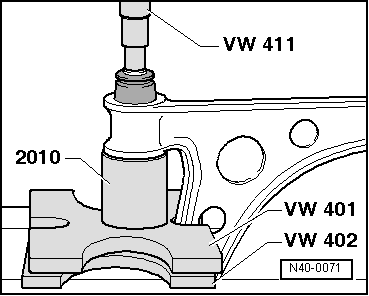Leon Mk2
| I - Assembly overview of strut, stabilizer bar and swinging arm up to year 2000 models |

| Special tools and workshop equipment required |
| t | Pressure plate -VW 401- |
| t | Pressure plate -VW 402- |
| t | Terminal crimper -VW 408 A- |
| t | Terminal crimper -VW 409- |
| t | Terminal crimper -VW 411- |
| t | Pressure plate -VW 447 i- |
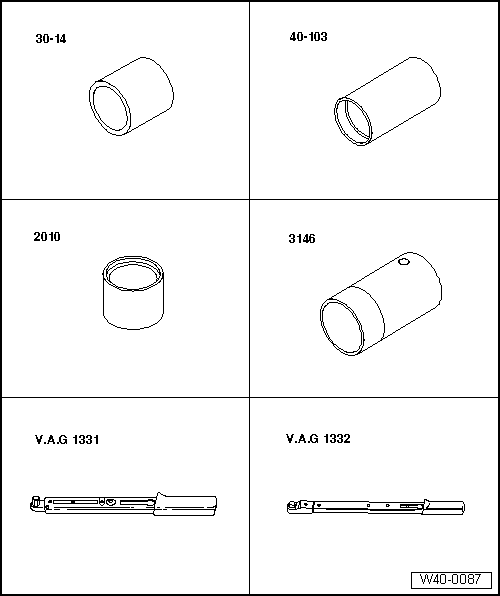
| t | Release pipe -30-14- |
| t | Supplement -40-103- |
| t | Tubular part -2010- |
| t | Tubular part -3146- |
| t | Torque wrench -V.A.G 1331- |
| t | Torque wrench -V.A.G 1332- |
 Note
Note| t | If a vehicle needs to be moved after the driveshaft has been removed, an outer joint must first be fitted in place of the driveshaft and tightened to 50 Nm to prevent damaging the wheel bearing. |
| t | No welding or straightening work can be done on the support and guide elements of the suspension system. |
| t | Always replace self-locking nuts following their removal. |
| t | Always replace corroded bolts/nuts. |

| 1 - | Strut |
| After assembly, the position of the steering wheel must be checked during a test drive. |
| If the steering wheel is misaligned, the convergence of the front axle must be checked and, if necessary, adjusted! |
| 2 - | Hexagonal nut, 55 Nm |
| 3 - | Rubber bush |
| 4 - | Self-locking nut, 100 Nm |
| q | Always replace |
| 5 - | Clamp |
| 6 - | Hexagonal bolt |
| 7 - | Hexagonal bolt M14 x 1.5 x 65 |
| q | 150 Nm, and turn a further 90° |
| q | Replace after each removal |
| 8 - | Stabilizer bar |
| q | Removing and fitting → Chapter |
| 9 - | Nut, 100 Nm |
| q | Allocation → Electronic parts catalogue“ETKA” |
| 10 - | Coupling rod |
| 11 - | Rear socket for the swinging arm |
| q | Releasing → Fig. |
| q | Assembly position → Fig. |
| q | Fitting → Fig. |
| 12 - | Hexagonal bolt M14 x 1.5 x 95 |
| q | 150 Nm, and turn a further 90° |
| q | Before tightening, check that the rear bonded rubber bush is correctly positioned on the strut → Fig. |
| q | Replace after each removal |
| 13 - | Allen screw, 55 Nm |
| 14 - | Ball joint |
| q | Removing and fitting → Chapter |
| 15 - | Self locking nut |
| q | 30 Nm, and turn a further 90° |
| q | Replace after each removal |
| q | When tightening, immobilize with Allen key e/c 7 |
| 16 - | Swinging arm |
| q | Assembly position on the strut → Fig. |
| q | Removing and fitting → Chapter |
| 17 - | Hexagonal bolt M14 x 1.5 x 90 |
| q | 90 Nm, and turn a further 90° |
| q | Replace after each removal |
| 18 - | Front socket for the swinging arm |
| q | Releasing → Fig. |
| q | Fitting → Fig. |
| 19 - | Hexagonal bolt, 100 Nm |
| If the pendulum support, pos. → Item, is made of aluminium, the tightening torque must be 70 Nm |
| Modifications to bolt → Chapter |
| 20 - | Rubber bush |
| 21 - | Pendulum support |
| At the start of the series, supports with two and three holes were manufactured to be fitted on the strut. |
| After a brief initial stage, supports are now manufactured with only one hole. |
| Only one-hole supports are supplied as spare parts |
| If this support is to be fitted onto a vehicle previously fitted with a different support, two 2.5 mm thick spacer washers must also be fitted. |
| Other modifications to the pendulum support → Chapter |
| 22 - | Hexagonal nut |
| q | 90 Nm, and turn a further 90° |
| q | Replace after each removal |
| 23 - | Hexagonal bolt |
|
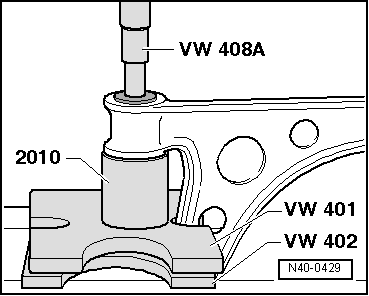
|
|
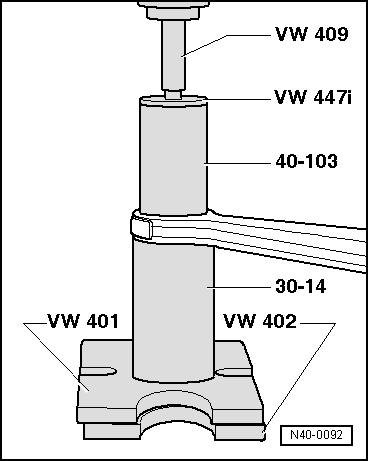
|
|
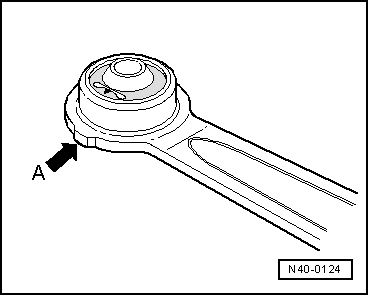
|
|
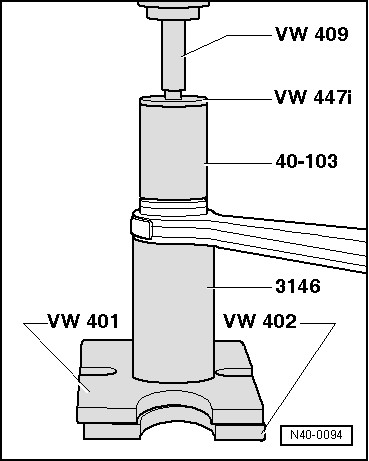
|
|
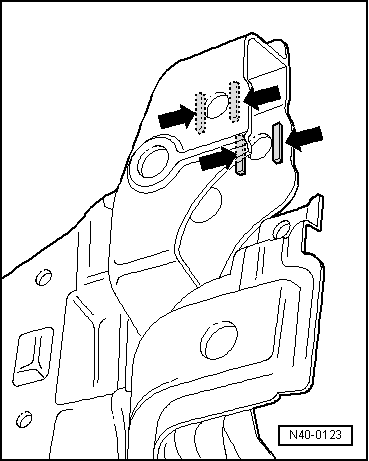
|

